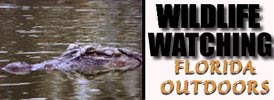


Wildlife Information
Alligators
Black Bear
Whooping Crane
Bald Eagle
Manatee
Florida Panther
Brown Pelican
Florida Wildlife - Black Bear
Perhaps no other animal has so excited the human imagination as the bear. References to bears are found in literature, folk songs, legends, mythology, fairy tales, and cartoons.
The American black bear inhabits wooded and mountainous areas throughout most of North America, from Alaska to Florida, Canada to Mexico. The black bear is approximately 5 feet long and varies in weight from 125 to 400 pounds. It has small eyes, rounded ears, a long snout, a large body, and a short tail. The shaggy hair varies in color from white through chocolate brown, cinnamon brown, and blonde to black, but most black bears are indeed black or a darker shade of brown. While black bears are capable of standing and walking on their hind legs, the usual posture is on all fours. The black bear's characteristic shuffle results from walking flat-footed, with the hind legs slightly longer than the front legs. Each paw has five strong, non-retractable claws used for tearing, digging, and climbing. One blow from a powerful front paw is enough to kill an adult deer. But in spite of their size and strength, black bears are surprisingly agile and careful in their movements. Although much of its historical habitat has been destroyed by axe, plow, and bulldozer, the highly intelligent black bear has adapted and survived. Black bears are opportunistic feeders, making use of just about any available food source. While they prefer berries, nuts, grass, and other plants, they also eat carrion, small animals, and fish. When fall approaches, black bears must eat large amounts of food in order to gain enough weight to sustain them through their winter hibernation, when they survive on their reserves of body fat. During periods of relatively warm weather, they may awaken and take short excursions outside. Black bears reach breeding maturity at about 4 or 5 years of age, and breed every 2 to 3 years. Black bears breed in the spring, usually in May and June, but the embryos do not begin to develop until the mother dens in the fall to hibernate through the winter months. However, if food was scarce and the mother has not gained enough fat to sustain herself during hibernation as well as produce cubs, the embryos do not implant (develop). Black bear cubs are generally born in January or February. The blind cubs weigh about « to 3/4 of a pound at birth, and twins are most common. By spring thaw, when the bears start leaving their dens, the cubs are fur-balls of energy, inquisitive and playful. They are weaned between July and September of their first year, and stay with the mother through the first full winter. They are usually independent by the second winter. Cub survival is totally dependent on the skill of the mother in teaching her cubs what to eat, where and how to forage (find food), where to den, and when and where to seek shelter from heat or danger. Except for breeding and raising young, black bears are generally solitary animals. They try to avoid humans and are considered non-aggressive except when injured, protecting their young, or protecting themselves. Daily movements are influenced greatly by temperature and food availability. Bears usually feed in the cool of the evening or early morning. During the heat of the day, they will seek shade in dense underbrush. Home ranges are determined by food types, abundance, and availability, and can be as small as 1 square mile or as great as 100 square miles. Rugged terrain and dense shrubs provide escape cover and den sites for black bears. Black bears also seek den sites under fallen trees, in hollow trees or caves, or in previously occupied dens. They are excellent tree climbers, and will use trees to escape from danger. When possible, black bears will choose streams with dense bankside shrubbery as travel corridors to and from food sources. The black bear's primary predator is man. During the American colonial period and after, black bears were hunted almost to extinction on the East Coast. Many states paid bounties for bears, and as late as 1977, there was still a bounty law on the books in Highland County, Virginia (even though it had been more than 30 years since the last bounty was paid). In addition to the historical uncontrolled harvest encouraged by bounties, black bear numbers were reduced by timber harvesting and burning, clearing land for crops and grazing, and other encroachments associated with an expanding civilization. By the early 1900s, the once-numerous black bear could be found only in remote mountainous areas of Georgia, Kentucky, Maryland, North Carolina, Pennsylvania, Tennessee, Virginia, and West Virginia. As small farms failed and people moved back to the cities, bear habitat slowly recovered and populations started to increase. The early establishment of national parks and national forests in the East helped save the black bear in that region. Although attitudes concerning bears and other game animals were changing and wildlife laws protecting black bears and other animals were being enacted, the understanding of black bear biology, behavior, and habitat requirements remained incomplete. It wasn't until the 1960s that methods and techniques for safely trapping, immobilizing, and handling such powerful animals were developed. More has been learned about the habits and needs of the black bear in the last 30 years than in all of recorded history. Thanks to this new knowledge and understanding, and better management, black bear populations have recovered significantly. However, they are not out of danger. Today, a major threat to the American black bear is widespread poaching, or illegal killing, to supply Asian markets with bear gall bladders and paws, considered to have medicinal value in China, Japan, and Korea. The demand for these parts also affects grizzly and polar bears. The Convention on International Trade in Endangered Species of Wild Fauna and Flora (also known as CITES), a treaty among more than 120 nations, provides measures to curb illegal trade in wildlife and wildlife products across international boundaries, helping to protect the black bear from poaching. The U.S. Fish and Wildlife Service is the agency responsible for the U.S. government's compliance with the CITES treaty. Two subspecies found in the southeastern U.S., the Louisiana black bear and the Florida black bear, still face decline mainly due to habitat loss and degradation. In 1992, the U.S. Fish and Wildlife Service listed the Louisiana black bear as a threatened species under the Endangered Species Act, meaning it could become in danger of extinction throughout all or a significant portion of its range in the foreseeable future. The American black bear also is protected by the Act in the affected states (Louisiana, Mississippi, and Texas) due to its close resemblance to this subspecies. The Florida black bear is a candidate for protection of the Endangered Species Act. The U.S. Fish and Wildlife Service monitors the animal's status and takes appropriate measures to ensure its conservation.
Information provided by:
Fish and Wildlife Service
















